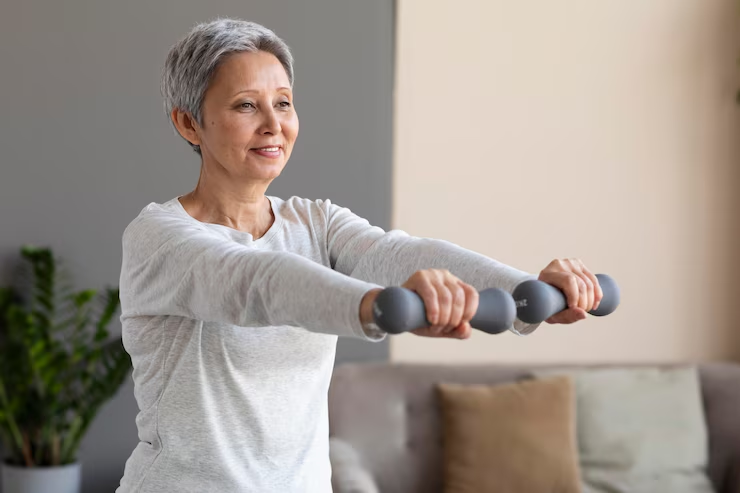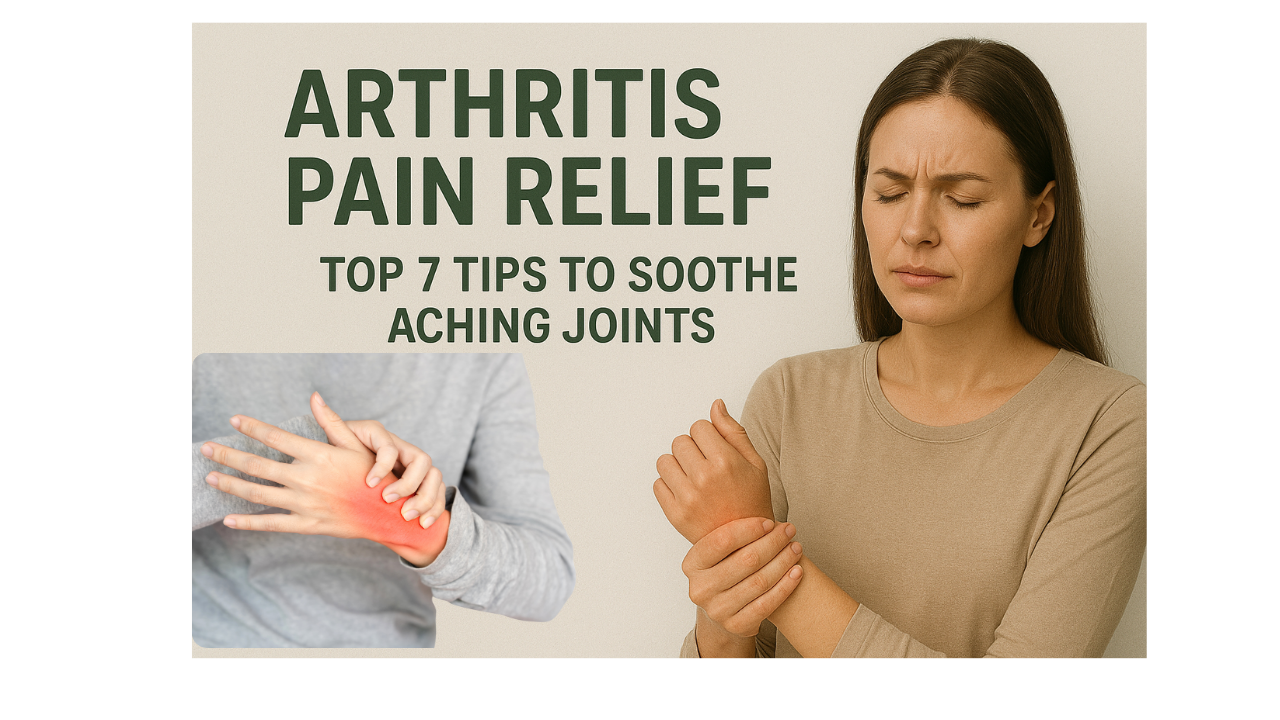Arthritis is a common health condition that affects over 350 million people around the world. It refers to more than 100 different joint-related disorders, with osteoarthritis (OA) and rheumatoid arthritis (RA) being the most common. These conditions typically lead to joint pain, swelling, stiffness, and reduced mobility, making daily tasks more difficult for many individuals.
Although arthritis can be tough to live with, it doesn’t have to take over your life. By understanding the condition and taking a proactive approach, many people find ways to reduce discomfort and stay active. Simple lifestyle changes, proper care, and the right mindset can make a big difference in managing symptoms and staying in control.
This helpful guide will take you through the basics of arthritis, including its causes and warning signs. Most importantly, it will share the Top 7 Tips for Effective Arthritis Pain Relief to help you lead a more comfortable and active life.
Understanding Arthritis: A Quick Overview
Before diving into pain relief strategies, it’s crucial to understand what arthritis is and why it happens.
What is Arthritis ?
Arthritis is a health condition that leads to swelling and pain in one or more joints. It affects how the joints move and feel, often making daily tasks more difficult. This condition can develop slowly over time or appear suddenly, depending on the type and cause.
When someone has arthritis, inflammation is usually present in the joints. This inflammation can cause stiffness, making it hard to move the joint normally. Many people also experience warmth, redness, and tenderness in the affected areas, especially after rest or long periods of sitting.
Over time, untreated or severe arthritis may lead to lasting damage in the joints. This damage can include the wearing down of cartilage, bone changes, or even joint deformity in serious cases. These changes may make the joint less flexible and more painful.
Finding effective arthritis pain relief is important for improving quality of life. With the right treatments, including exercise, therapy, and healthy habits, many people can reduce pain and move more freely despite their condition.

Types of Arthritis
Osteoarthritis (OA) – Caused by wear and tear on the joints, usually due to aging or overuse.
Rheumatoid Arthritis (RA) – An autoimmune disease where the body attacks its own joints.
Psoriatic Arthritis – Related to the skin condition psoriasis.
Gout – Caused by the buildup of uric acid crystals in the joints.
Common Symptoms
Joint pain
Swelling
Redness and warmth
Reduced mobility
Morning stiffness
Fatigue (especially in RA)
Top Tips for Arthritis Pain Relief
Here are the top 7 most effective, science-backed, and practical ways to reduce arthritis pain and improve joint function.
Stay Active with Low-Impact Exercise

Staying active is one of the most helpful ways to support joint health, especially for those living with arthritis. Regular movement helps keep the joints flexible, which is important for maintaining mobility and reducing stiffness. Simple exercises like walking, stretching, or swimming can make a big difference over time.
Movement also strengthens the muscles around the joints. Stronger muscles offer better support and stability, helping to reduce pressure on the joints themselves. This support lowers the risk of further joint damage and can improve balance and coordination as well.
For people seeking arthritis pain relief, adding gentle physical activity into their daily routine is a smart and natural step. It may not remove pain completely, but it can greatly reduce discomfort and improve quality of life. Always start slowly and choose activities that are joint-friendly, focusing on consistency rather than intensity.
Best exercises for arthritis:
Walking: Gentle on joints and promotes cardiovascular health.
Swimming or Water Aerobics: The buoyancy of water supports joints, reducing strain while allowing movement.
Yoga and Tai Chi: Improve flexibility, balance, and reduce stress.
Cycling: Low-impact and great for joint mobility.
Pro Tip: Start slow. Even 10–15 minutes a day can make a difference. Always warm up and cool down to avoid joint stress.
Maintain a Healthy Weight
Carrying extra body weight puts added stress on your joints, especially your knees. In fact, for every extra pound you carry, your knees feel around four pounds of added pressure. This extra load can increase wear and tear on the joints and worsen arthritis symptoms over time.
Fat tissue in the body doesn’t just store energy—it also releases chemicals that can increase inflammation. This added inflammation can make joint pain and stiffness more severe. Reducing body fat can help lower this inflammation and ease the pressure on joints, making movement easier.
If you’re looking for effective arthritis pain relief, managing your weight is a powerful step. Even a small amount of weight loss can make a noticeable difference in how your joints feel. Along with regular exercise and healthy eating, weight loss can lead to better joint function, less pain, and a more active, comfortable life with arthritis.
Benefits of weight loss:
Decreased joint stress
Reduced inflammation
Improved energy levels and mobility
Healthy weight loss tips:
Eat balanced meals with whole grains, lean proteins, and healthy fats.
Avoid sugary drinks and processed snacks.
Practice portion control.
Consult a dietitian for a tailored plan.

Real Result: Losing just 10 pounds can reduce the risk of developing osteoarthritis in the knees by 50%.
Use Hot and Cold Therapy
Temperature therapy is a simple and effective way to ease joint pain and stiffness. It involves using heat or cold to help manage symptoms of arthritis. Heat therapy, such as warm towels or heating pads, helps relax muscles, improve circulation, and ease stiffness in the joints.
On the other hand, cold therapy can reduce swelling and numb sharp pain. Applying an ice pack to swollen joints can bring quick relief, especially after physical activity. Alternating between heat and cold can be useful depending on how the joints feel at different times of the day.
For those seeking arthritis pain relief, temperature therapy can be a helpful part of their daily routine. It’s easy to do at home and offers quick results, especially when used with other treatments. Always use caution to avoid burns or frostbite, and consult a healthcare provider if you’re unsure which method is best for your condition.
How to use:
Heat Therapy (for stiffness): Use warm towels, heating pads, or warm baths to increase blood flow and relax muscles.
Cold Therapy (for inflammation): Apply ice packs to reduce swelling and numb pain.
Tips:
Apply for 15–20 minutes at a time.
Always wrap hot or cold packs in a cloth to avoid skin damage.
Try alternating between hot and cold for chronic pain.
Eat an Anti-Inflammatory Diet

Inflammation plays a big role in causing arthritis pain and stiffness. When the joints are inflamed, they can become swollen, tender, and harder to move. Managing this inflammation is important for anyone looking to reduce discomfort and stay active.
One natural way to fight inflammation is through diet. Certain foods, such as fruits, vegetables, nuts, seeds, and fatty fish, are known to have anti-inflammatory properties. These foods help protect the joints and can support long-term joint health when included in your daily meals.
For those seeking arthritis pain relief, focusing on an anti-inflammatory diet can be a smart and simple step. Avoiding processed foods, sugary snacks, and excess red meat can also make a difference. Over time, these healthy food choices may reduce swelling, ease pain, and improve how your joints feel and move each day.
Foods to Eat:
Fatty Fish (like salmon, tuna, sardines): Rich in omega-3 fatty acids.
Berries: Packed with antioxidants.
Leafy Greens (spinach, kale): Anti-inflammatory and full of nutrients.
Olive Oil: Contains healthy fats that act like ibuprofen in the body.
Nuts (almonds, walnuts): Great source of fiber and healthy fats.
Foods to Avoid:
Sugar and high-fructose corn syrup
Saturated fats (from red meat and fried food)
Refined carbs (white bread, pastries)
Processed snacks
Sample Meal: Grilled salmon, quinoa salad with kale and blueberries, a handful of walnuts, and a drizzle of olive oil.
Use Assistive Devices and Joint Support
Proper joint support plays a key role in reducing pain and preventing further damage. When joints are not supported well, they can wear down more quickly, leading to increased discomfort and limited movement. Everyday actions like walking, bending, or lifting can become painful if the joints are under too much pressure.
Using supportive tools or adjusting how you move can ease this strain. Items like braces, canes, or cushioned shoes help take pressure off painful joints. Simple changes in posture or body mechanics can also protect your joints during daily tasks.
For anyone looking for effective arthritis pain relief, joint support should be a part of their plan. By reducing stress on the joints, you can move more easily and with less pain. Over time, this can improve your comfort and help you stay active without worsening the condition. Small adjustments often bring lasting results in managing arthritis symptoms.
Types of aids:
Canes or walkers: Help with balance and reduce joint pressure.
Braces and sleeves: Provide compression and support to specific joints.
Orthotic shoes: Support arches and reduce impact.
Ergonomic tools: Special grips, jar openers, and easy-to-use utensils.
Pro Tip: Work with an occupational therapist to customize tools that fit your lifestyle and specific needs.

Manage Stress and Sleep Better
Chronic stress and lack of sleep can make arthritis pain feel worse. When you’re stressed, your body becomes more sensitive to pain signals. Stress can also cause muscles to tense up, which adds more pressure to already painful joints, making daily movement more uncomfortable.
Sleep is another important part of managing pain. Poor sleep affects how your body handles pain, often making it harder to cope with arthritis symptoms during the day. Without enough rest, your joints may feel stiffer, and your energy levels may drop, making it harder to stay active.
If you’re aiming for better arthritis pain relief, it’s important to manage stress and improve sleep. Relaxation techniques like deep breathing, meditation, or gentle stretching can help calm your mind and body. Creating a regular bedtime routine and avoiding screens before bed may also lead to better rest and less pain, helping you feel stronger and more in control.
Stress-reduction techniques:
Meditation and deep breathing
Guided imagery
Journaling or gratitude practices
Cognitive-behavioral therapy (CBT)
Sleep hygiene tips:
Stick to a regular sleep schedule.
Avoid caffeine and screens before bed.
Use supportive mattresses and pillows.
Consider relaxation techniques like progressive muscle relaxation.
Did You Know? Studies show that people with arthritis who sleep poorly report more severe pain and functional limitations.
Explore Medications and Alternative Therapies

Sometimes, lifestyle changes alone may not fully relieve arthritis symptoms. When joint pain and stiffness continue to interfere with daily life, additional support may be needed. In such cases, medications or natural therapies can help manage discomfort more effectively.
There are many treatment options available, from over-the-counter pain relievers to prescribed anti-inflammatory drugs. These can reduce swelling, improve joint function, and make movement easier. Holistic approaches like acupuncture, massage, or physical therapy may also offer benefits without strong side effects.
For those seeking stronger arthritis pain relief, combining these options with healthy habits can lead to better results. It’s important to work with a healthcare provider to find the right mix of treatments that fit your needs and lifestyle. With the right support, many people can take control of their pain and continue to live an active and comfortable life despite arthritis.
Over-the-Counter Medications:
NSAIDs (ibuprofen, naproxen): Reduce pain and inflammation.
Acetaminophen: Less anti-inflammatory effect but good for pain.
Prescription Medications:
DMARDs (for RA): Slow down immune system damage.
Biologics: Target specific immune pathways.
Corticosteroids: For severe inflammation.
Alternative Therapies:
Acupuncture: Shown to relieve pain and stiffness.
Massage therapy: Increases blood flow and reduces muscle tension.
Supplements: Glucosamine, chondroitin, turmeric (check with your doctor first).
Caution: Always consult your healthcare provider before starting new medications or supplements.
Bonus Tips for Arthritis Management
Stay Hydrated: Dehydration can worsen joint lubrication. Drink at least 8 glasses of water daily.
Track Your Symptoms: Keep a pain diary to notice patterns and triggers—helpful during doctor visits.
Regular Checkups: Stay ahead of arthritis progression by keeping regular appointments with your rheumatologist or primary care physician.
Living Well with Arthritis: A Holistic Approach
Arthritis is a long-term condition, but it doesn’t have to control your life. With a mix of medical care and smart lifestyle choices, you can manage symptoms and feel more in control. Staying active, eating well, and understanding your condition are key steps toward better health.
Even small changes like walking daily, adjusting your meals, or trying yoga can lead to steady improvements. These habits support joint health and may ease stiffness and pain over time. The goal is to stay consistent and listen to your body.
If you’re looking for lasting arthritis pain relief, patience and persistence are important. Relief may take time, but every step you take brings you closer to a more active, comfortable life.
Conclusion

Living with arthritis can be challenging, but with the right strategies, managing symptoms and improving quality of life is entirely possible. Incorporating lifestyle changes such as low-impact exercise, a nutritious anti-inflammatory diet, and weight management plays a vital role in achieving effective arthritis pain relief. These practices not only reduce discomfort but also enhance mobility and joint strength over time.
It’s equally important to address emotional well-being through stress management techniques and quality sleep, both of which influence how we perceive and cope with chronic pain. Supplementing these efforts with supportive therapies—such as heat/cold treatments, assistive devices, and approved medications—creates a balanced and proactive approach to managing arthritis.
Consistency is key. Whether you’re newly diagnosed or have been managing arthritis for years, applying these strategies can make a significant difference. Remember, arthritis pain relief is not just about easing symptoms—it’s about empowering yourself to live actively, comfortably, and confidently every day.
FAQs
Q.1 What is the fastest way to get arthritis pain relief ?
The fastest methods include applying ice or heat to affected joints, using over-the-counter pain relievers like ibuprofen or acetaminophen, and doing gentle stretching exercises. For long-term relief, a combination of medication, lifestyle changes, and physical therapy is most effective.
Q.2 Can diet really help reduce arthritis pain ?
Yes, a healthy, anti-inflammatory diet can significantly reduce arthritis symptoms. Foods rich in omega-3 fatty acids, antioxidants, and fiber—like fish, berries, leafy greens, and nuts—can help reduce joint inflammation and pain.
Q.3 Is exercise safe for people with arthritis ?
Absolutely. Low-impact exercises like walking, swimming, and yoga can strengthen muscles around the joints, improve flexibility, and reduce stiffness. Always consult a doctor or physical therapist before starting a new routine.
Q.4 What natural remedies work for arthritis pain relief ?
Natural remedies like turmeric, omega-3 supplements, acupuncture, massage therapy, and hot/cold compresses can complement traditional treatments and offer relief. However, consult your doctor before trying any new supplements or therapies.
Q.5 When should I see a doctor for arthritis pain ?
See a doctor if joint pain is persistent, worsening, or interfering with daily activities. Also, seek medical help if you notice swelling, redness, or stiffness lasting more than a few days, as these could be signs of worsening arthritis or another condition.



